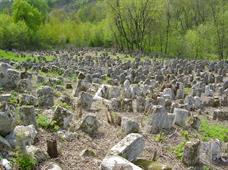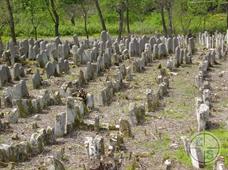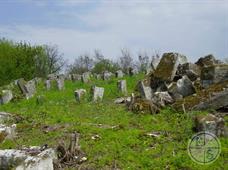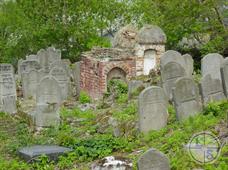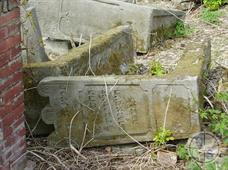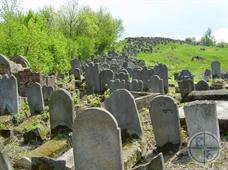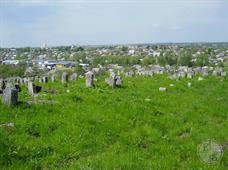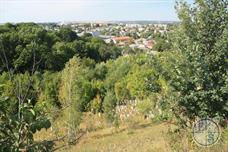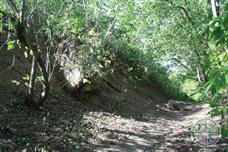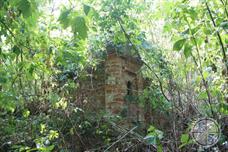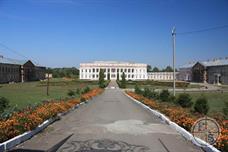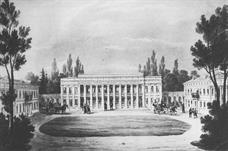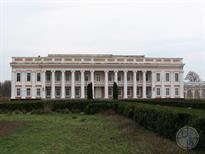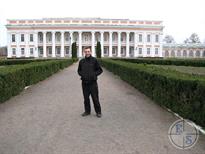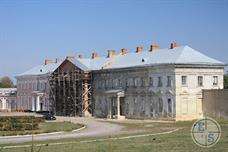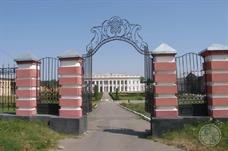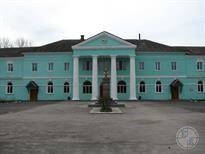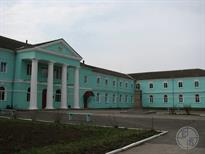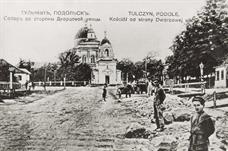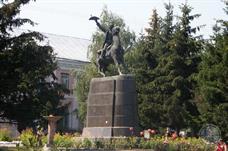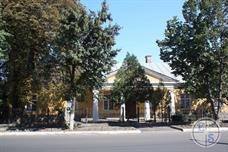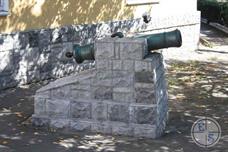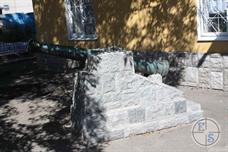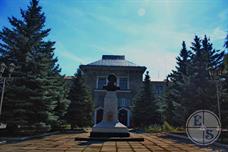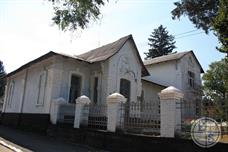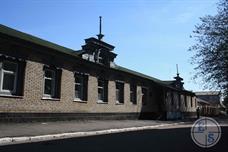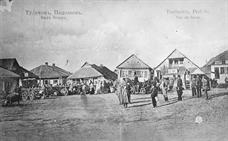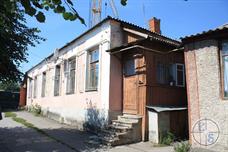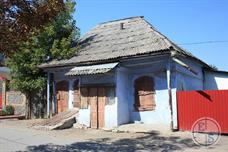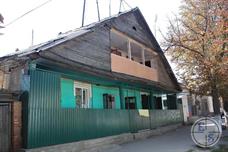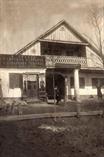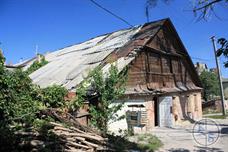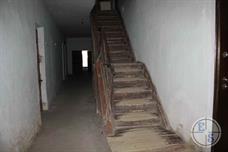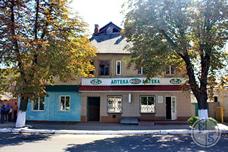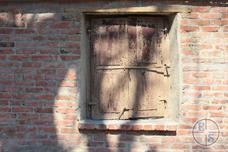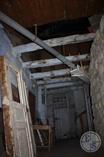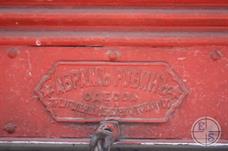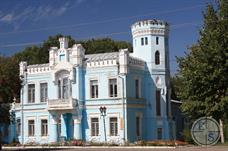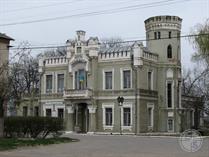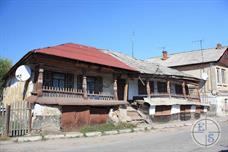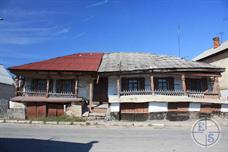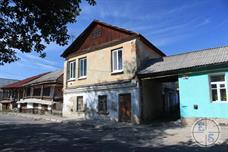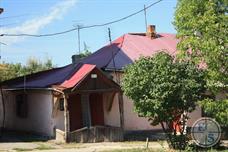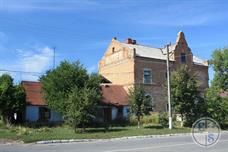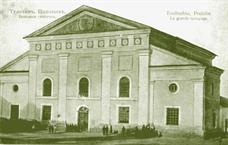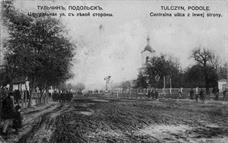Tulchin
Tulchin, 2008, 2012, 2015
Since 1607 under the name Nestervar settlement is mentioned in the Acts of Lublin Crown Tribunal in connection with the resettlement here runaway peasants. In these acts in 1613 for the first time and found the name of Tulchin. Other documents of the XVII century there are two names of the city - Nestervar and Tulchin.
The Polish king Sigyzmund III in 1609 gave Nestervar as a military award of Bratslav and Vinnitsa headman Alexander Kalinovsky Valente, who owned vast latifundia at Bratslav and Kyiv region.
Tulchin owner in 1726 became the Belz governor Stanislaw Potocki, who, being a distant relative Kalinovskys, Tulchin got together with the other possessions of the once famous, but extinct in the early XVIII century kind. Thanks to the efforts of Stanislaw Felix (Szczęsny) Potocki, Tulchin, despite the troubled history of the region in the XVIII century, became an important commercial and industrial and cultural center of Bratslav. Stanislav Felix moved the family residence here from Kristinopolya, after the partition of Poland in 1772, appeared on the territory of the Austrian Galicia.
The Polish king Sigyzmund III in 1609 gave Nestervar as a military award of Bratslav and Vinnitsa headman Alexander Kalinovsky Valente, who owned vast latifundia at Bratslav and Kyiv region.
Tulchin owner in 1726 became the Belz governor Stanislaw Potocki, who, being a distant relative Kalinovskys, Tulchin got together with the other possessions of the once famous, but extinct in the early XVIII century kind. Thanks to the efforts of Stanislaw Felix (Szczęsny) Potocki, Tulchin, despite the troubled history of the region in the XVIII century, became an important commercial and industrial and cultural center of Bratslav. Stanislav Felix moved the family residence here from Kristinopolya, after the partition of Poland in 1772, appeared on the territory of the Austrian Galicia.
With the inclusion of Bratslav province in the Russian Empire (in the second partition of Poland in 1793) became the chief town of Tulchin formed in 1795 Bratslav governorship, from 1797 - Podolsk province, and in 1804 turned into a provincial town Bratslav County. Likely reasons for lowering the status of the city might be its pronounced possessory in nature, as well as the overwhelming predominance of Jews among local merchants, which inevitably would give them a majority in the main in the district urban management.
Since 1796 in Tulchin constantly quartered units of the Russian army. In the years 1796-1797 there was the headquarters of the commander Alexander Suvorov.
In 1818 in Tulchin he was transferred to the headquarters of the 2nd Army under the command of Hero of Russian-French War, General P.H.Vitgenshteyna. At the army headquarters in the city and moved to the future Decembrist Pavel Pestel. Here, a circle of liberal officers formed away from the all-seeing eye of imperial administration - the so-called secret council Tulchinskaya noble society "Union of Welfare"
Since 1796 in Tulchin constantly quartered units of the Russian army. In the years 1796-1797 there was the headquarters of the commander Alexander Suvorov.
In 1818 in Tulchin he was transferred to the headquarters of the 2nd Army under the command of Hero of Russian-French War, General P.H.Vitgenshteyna. At the army headquarters in the city and moved to the future Decembrist Pavel Pestel. Here, a circle of liberal officers formed away from the all-seeing eye of imperial administration - the so-called secret council Tulchinskaya noble society "Union of Welfare"
Perhaps the Jews were among the first residents of Tulchin. Some, however, very uncertain picture of the size of the Jewish population of the city on the eve of the Khmelnytsky can be obtained from information about Tulchin defenders and victims of the infamous massacre, arranged here by the Cossacks in summer 1648 in the Jewish chronicles presented different information, "there gathered about two thousand Jews" He writes p. Nathan Note Hannover "Yeven metsula" ( "bottomless abyss").
It should also be borne in mind that the number of victims of the tragedy were Tulchin and refugees from other settlements in the region. The author of "Titus Gayaven" Tulchin determined number of Jewish communities in 100 householders: in other words, the city had about 100 Jewish homes. Assuming that these data are close to reality, in these houses could accommodate about 600 people (an average of six people per family). Tulchin Jewish population in the middle of the XVII century in historical research. often estimated at 2 000 people, apparently on the basis of reports of the most popular Jewish chronicles Khmelnytsky era. Anyway, Tulchinskaya community was one of the biggest and well-known in the Bratslav. It is possible that in the local yeshiva, headed by p. Joshua, the son of Aaron p. Meir of Lviv, studied Jewish youths from nearby settlements.
It should also be borne in mind that the number of victims of the tragedy were Tulchin and refugees from other settlements in the region. The author of "Titus Gayaven" Tulchin determined number of Jewish communities in 100 householders: in other words, the city had about 100 Jewish homes. Assuming that these data are close to reality, in these houses could accommodate about 600 people (an average of six people per family). Tulchin Jewish population in the middle of the XVII century in historical research. often estimated at 2 000 people, apparently on the basis of reports of the most popular Jewish chronicles Khmelnytsky era. Anyway, Tulchinskaya community was one of the biggest and well-known in the Bratslav. It is possible that in the local yeshiva, headed by p. Joshua, the son of Aaron p. Meir of Lviv, studied Jewish youths from nearby settlements.
Over the next few decades, restless Jews are not mentioned in the Polish documents related to the history of Tulchin, who became in accordance contract Zbarouski 1649 hundreds of cities Bratslav regiment.
Thanks to the efforts of Francis Saleziya (nicknamed "the prince of Rus') and, mainly, his son Felix Stanislas Potocki, Tulchin, despite the troubled history of the region in the XVIII century, became an important commercial and industrial and cultural center of Bratslav. Stanislav Felix moved the family residence here from Kristinopolya, after the partition of Poland in 1772, appeared on the territory of the Austrian Galicia.
Perhaps the only evidence of the existence of the Jewish community Tulchin in these times is not interrupted, it may serve as a tombstone in 1732, found in the old Jewish cemetery: it is installed on the grave of Rabbi Abraham son r.Shaulya.
Restoring an ordered community life of Jews in Bratslav proceeded in a troubled situation raids Haidamak gangs, the occurrence of which refers to the 1717 official documents.
The Jewish community of Tulchin, while still in 1765 the average for the number of edges among communities by the end of the XVIII century. It has become one of the most significant in the region. A census in 1765 counted 307 Jews in the city and 6 more - in the suburbs. By Tulchin community were attributed to Jews as from 22 surrounding villages (eg Timanovke lived 22 Jews in Kopievke - 9). In total, there were 452 Jewish community; Census data is assured Rabbi Kelman Abelovich "quarterly" Michael Leibowitz and "student" Yitzhak Volovich.
Thanks to the efforts of Francis Saleziya (nicknamed "the prince of Rus') and, mainly, his son Felix Stanislas Potocki, Tulchin, despite the troubled history of the region in the XVIII century, became an important commercial and industrial and cultural center of Bratslav. Stanislav Felix moved the family residence here from Kristinopolya, after the partition of Poland in 1772, appeared on the territory of the Austrian Galicia.
Perhaps the only evidence of the existence of the Jewish community Tulchin in these times is not interrupted, it may serve as a tombstone in 1732, found in the old Jewish cemetery: it is installed on the grave of Rabbi Abraham son r.Shaulya.
Restoring an ordered community life of Jews in Bratslav proceeded in a troubled situation raids Haidamak gangs, the occurrence of which refers to the 1717 official documents.
The Jewish community of Tulchin, while still in 1765 the average for the number of edges among communities by the end of the XVIII century. It has become one of the most significant in the region. A census in 1765 counted 307 Jews in the city and 6 more - in the suburbs. By Tulchin community were attributed to Jews as from 22 surrounding villages (eg Timanovke lived 22 Jews in Kopievke - 9). In total, there were 452 Jewish community; Census data is assured Rabbi Kelman Abelovich "quarterly" Michael Leibowitz and "student" Yitzhak Volovich.
By the end of the XVIII century. Tulchin became the largest Jewish settlement in the province, surpassing in number the Jewish community of Nemirov. At the turn of the century here there were 1313 Jews (in Nemyriv - 958). The increase in the Jewish population more than quadrupled in the last third of the XVIII century. I had a period of improvement of the city its new owner Felix Stanislav Potocki. Another factor in the growth of the Jewish community was Tulchin turning into an important center of the Hasidic movement. The town chose as his residence is very controversial, but popular Tzaddik, p. Boruch - grandson of the founder of Hasidism, the Baal Shem Tov.
The composition of the population is represented in topographical description of the town follows: nobles who had their estates, -11 persons, petty "chinshevoy" gentry - 57 (10 yards), ministers in the court of the owner - 87 (4 yard), Orthodox duhovenstva18 (2 yard) Catholic clergy - 13 men (living, probably in the monastery), the middle class 1511 (246 yards), the Germans - 20 (3 courtyard), French - 11 (2 yard), the Greeks - 6, Roma - 8, the Jews - 1313 (297 households).
In the years 1796- 1797 there was the headquarters of the commander Alexander Suvorov. The constant presence of a large military contingent, the many and varied needs of the army and army ranks Tulchinsk favored the development of the market, provided the work of craftsmen of all specialties and traders of all categories and subsequently shielded Tulchin community from 1881-1882, pogroms. and of 1905-1906.
The composition of the population is represented in topographical description of the town follows: nobles who had their estates, -11 persons, petty "chinshevoy" gentry - 57 (10 yards), ministers in the court of the owner - 87 (4 yard), Orthodox duhovenstva18 (2 yard) Catholic clergy - 13 men (living, probably in the monastery), the middle class 1511 (246 yards), the Germans - 20 (3 courtyard), French - 11 (2 yard), the Greeks - 6, Roma - 8, the Jews - 1313 (297 households).
In the years 1796- 1797 there was the headquarters of the commander Alexander Suvorov. The constant presence of a large military contingent, the many and varied needs of the army and army ranks Tulchinsk favored the development of the market, provided the work of craftsmen of all specialties and traders of all categories and subsequently shielded Tulchin community from 1881-1882, pogroms. and of 1905-1906.
The Jewish community numbered Tulchin at the turn of the XVIII-XIX centuries, more than 1 300 people, possessed a synagogue and two kloyzami ( "Jewish rock school with two similar prishkolkami"). The results of measurements of the synagogue ruins, made in 1948, probably before their demolition, saying that the building had a traditional plan: a square in terms of two tiers of windows the main hall area of about 400 m2 was surrounded on three sides (except the east) one-story porches.
In 1832, to the merchant class of Tulchin belonged to 27 Jews and one Christian. Such a large number of merchants guild was not in any other city in the region. Local merchants traded with the major cities in the south of the Russian Empire, as well as abroad.
In 1889. Tulchinskaya community numbered 15,000 people, there were 14 officially registered "spiritual boards" at the synagogue and prayer houses. The place where he lived County breech Rabbi, possess, respectively, the status of the district of the Jewish center.
At the beginning of the XX century in Tulchin was 2500 households and 23252 inhabitants. The community contains 18 synagogue and houses of worship, as well as its own hospital; children received a traditional education boleё than 70 heders. In his role as the treasury rabbi at this time was Yakov Yehuda Grinshpun. All four of the city doctor and dentist were Jews. Ownership or lease of all the Jews owned industrial enterprises.
In 1832, to the merchant class of Tulchin belonged to 27 Jews and one Christian. Such a large number of merchants guild was not in any other city in the region. Local merchants traded with the major cities in the south of the Russian Empire, as well as abroad.
In 1889. Tulchinskaya community numbered 15,000 people, there were 14 officially registered "spiritual boards" at the synagogue and prayer houses. The place where he lived County breech Rabbi, possess, respectively, the status of the district of the Jewish center.
At the beginning of the XX century in Tulchin was 2500 households and 23252 inhabitants. The community contains 18 synagogue and houses of worship, as well as its own hospital; children received a traditional education boleё than 70 heders. In his role as the treasury rabbi at this time was Yakov Yehuda Grinshpun. All four of the city doctor and dentist were Jews. Ownership or lease of all the Jews owned industrial enterprises.
Pogroms of the Civil War did not pass Tulchin side.
A vicious pogrom was uchinёn in Tulchin on the night of July 31 August 1, 1919 a major gangster connection, led by the same Lyahovtsa. According to a Jew who escaped from the thugs in the village, representatives of the Orthodox intelligentsia contributed pogrom, which was the organizational center of Ukrainian cooperative partnership. At the same time, the local peasants for the most part have not participated in the pogrom, and vice versa, provided refuge to many Jews of Tulchin. Every Jew encountered bandits declared communist and killed. According to the report the committee of Vinnitsa help victims of pogroms 222 Jews were killed in Tulchin, after the pogrom in the city were 106 widows and 398 orphans.
In 1925, the Jewish local council was established here. In 1926 Tulchin officially received the status of the city, and with the formation of the Vinnytsia region in 1932 became a district center.
In 1925 in Tulchin district hosted campaign liquidation of the Jewish religious communities, which resulted in the majority of cities and counties prayer houses were closed. It remains only a small number of synagogues, one of which was on the New Bazaar.
Before the war in 1939 there lived 5607 Jews (42% of the population).
A vicious pogrom was uchinёn in Tulchin on the night of July 31 August 1, 1919 a major gangster connection, led by the same Lyahovtsa. According to a Jew who escaped from the thugs in the village, representatives of the Orthodox intelligentsia contributed pogrom, which was the organizational center of Ukrainian cooperative partnership. At the same time, the local peasants for the most part have not participated in the pogrom, and vice versa, provided refuge to many Jews of Tulchin. Every Jew encountered bandits declared communist and killed. According to the report the committee of Vinnitsa help victims of pogroms 222 Jews were killed in Tulchin, after the pogrom in the city were 106 widows and 398 orphans.
In 1925, the Jewish local council was established here. In 1926 Tulchin officially received the status of the city, and with the formation of the Vinnytsia region in 1932 became a district center.
In 1925 in Tulchin district hosted campaign liquidation of the Jewish religious communities, which resulted in the majority of cities and counties prayer houses were closed. It remains only a small number of synagogues, one of which was on the New Bazaar.
Before the war in 1939 there lived 5607 Jews (42% of the population).
July 23, 1941 German military units virtually without a fight went to Tulchin. The Germans rounded up Jews in Kaptsanovku, the area of the Jewish quarters of the poor, there was created a ghetto (in the words of the old-timers, it happened on Yom Kippur 1941).
From eyewitness: "The Germans have left behind the Bug. Left Romanians and Magyars. Romanians were ordered to wear a black circle and a yellow star on it. There was food and water. Going beyond the ghetto allowed up to eight in the evening. In the market of the Jews beat the Romanians and the local policemen. Men are generally not allowed to leave the ghetto. They put out to work dismantling the ruins and rubble after the bombing. Uproot the forest, logs were loaded into boxcars. We are constantly guarded by armed soldiers with dogs. Labor exchange we were given 180 grams of bread a day. "
As established in September 1941, the Romanian province of "Transnistria" Tulchin became the center of the eponymous district administration headed by the Prefect; The city is the headquarters of the gendarmerie legion. In accordance with the order of the civil governor of Transnistria Aleksyanu of 11 November 1941 on the settlement of Jews in the so-called "colonies", 3005 Tulchin Jews were deported 13 December 1941 (the feast of Hanukkah) in the "colony" in Pechora.
From eyewitness: "The Germans have left behind the Bug. Left Romanians and Magyars. Romanians were ordered to wear a black circle and a yellow star on it. There was food and water. Going beyond the ghetto allowed up to eight in the evening. In the market of the Jews beat the Romanians and the local policemen. Men are generally not allowed to leave the ghetto. They put out to work dismantling the ruins and rubble after the bombing. Uproot the forest, logs were loaded into boxcars. We are constantly guarded by armed soldiers with dogs. Labor exchange we were given 180 grams of bread a day. "
As established in September 1941, the Romanian province of "Transnistria" Tulchin became the center of the eponymous district administration headed by the Prefect; The city is the headquarters of the gendarmerie legion. In accordance with the order of the civil governor of Transnistria Aleksyanu of 11 November 1941 on the settlement of Jews in the so-called "colonies", 3005 Tulchin Jews were deported 13 December 1941 (the feast of Hanukkah) in the "colony" in Pechora.
According to the memoirs of Svetlana Kogan-Rabinovich, "The ghetto was posted orders: all of us are sent to the Pechersk death camp" Dead loop ", and if we want to survive, have to pay the ransom on the list. It was a long queue. Everyone tried to get on the list and make a ransom. Snatches a golden tongs teeth. Regardless of the list, all sent to the death camp. Sick and elderly dragged on a stretcher. 80 people committed suicide. They were buried in two graves in Tulchin, which is now without a monument. Before shipment to the camp we were driven to school, Polizei helped Romanians and Hungarians. In school, we were kept for three days. It was close. You could barely stand. Not fed, the water is also not allowed. The toilet is also not allowed. Hungry and exhausted we were driven to the camp.
Walking column in which there were old men, children, women with babies, proceeded from Tulchin to Pechora in Ukrainian police cordon, German and Romanian soldiers with dogs. Stragglers from the column convoy shot. The Pechora, on the banks of the Bug River, near the border of the German occupation zone was established a concentration camp, where most of the prisoners were condemned to death. Tulchin Jews housed in the premises of the tuberculosis sanatorium in the former estate of Count Potocki, some of which remained unfinished buildings without windows and doors. "
According to official data from the 6500 Jewish prisoners in Pechersk camp, when his release by the Red Army in March 1944, remained alive 1550.
In the fall of 1941 in Tulchin district were deported the Jews of Bessarabia and Bukovina. Most of them are placed in a neighboring village Nestervarke; in the 1942-1943 biennium. here it was organized Jewish labor camp, where prisoners were used in the development of peat.
Walking column in which there were old men, children, women with babies, proceeded from Tulchin to Pechora in Ukrainian police cordon, German and Romanian soldiers with dogs. Stragglers from the column convoy shot. The Pechora, on the banks of the Bug River, near the border of the German occupation zone was established a concentration camp, where most of the prisoners were condemned to death. Tulchin Jews housed in the premises of the tuberculosis sanatorium in the former estate of Count Potocki, some of which remained unfinished buildings without windows and doors. "
According to official data from the 6500 Jewish prisoners in Pechersk camp, when his release by the Red Army in March 1944, remained alive 1550.
In the fall of 1941 in Tulchin district were deported the Jews of Bessarabia and Bukovina. Most of them are placed in a neighboring village Nestervarke; in the 1942-1943 biennium. here it was organized Jewish labor camp, where prisoners were used in the development of peat.
In 1942 in Tulchin were translated (in addition to 118 local evreyam- "experts" who have remained here after the deportation in Pecher) several hundred Jews deported from Bukovina and Ukrainian towns, in particular Yampol. By order of the gendarmerie ghetto Council was established and Jewish police. In March 1943, there were about 500 Jews in the ghetto. The money sent by the Jews of Bucharest ghetto Council organized a soup kitchen and several shops, many prisoners worked at the enterprises outside the ghetto. With the permission of the occupation authorities the school was established in the ghetto, headed by the wife of the chairman of the board Fishman ghetto. School visited ninety boys and girls enrolled in addition to other production fields. Two musicians of the prisoners were in the school music classes. Teachers involved with the memory of children without books and manuals, children learn without textbooks and notebooks.
According to the testimony of former prisoners, in the end of January 1944 the German army unit surrounded the ghetto, with its destruction, but through the intervention of Commander of the Legion of Romanian gendarmerie captain Fetekau, bloodshed happened. In the Odessa regional archive stored lists of prisoners Tulchinsk ghetto.
According to the testimony of former prisoners, in the end of January 1944 the German army unit surrounded the ghetto, with its destruction, but through the intervention of Commander of the Legion of Romanian gendarmerie captain Fetekau, bloodshed happened. In the Odessa regional archive stored lists of prisoners Tulchinsk ghetto.
According to official Romanian statistics dated September 1, 1943 in Tulchin were 7 Jews from Bessarabia and 220 Jews from Bukovina, in Nestervarke, respectively - 422 and 1168 deported Jews.
In the 1950s, it employs in its composition about 2,500 Tulchin Jewish community was one of the largest in the Vinnitsa region, second largest only Vinnitsa, Mogilev and Zhmerinka.
In 1994, there were about 500 Jews (about 2.5% of the population)
In 2012, the Jewish community Tulchin employs about 150 people. At the same time, following the rule of the anecdote, according to which two Jews on a desert island built three synagogues (in particular walking alone, in the second - the other, the third two or foot), in the city of 2 competing Jewish communities have been established, the religious and progressive ...
Material: V.Lukin, "100 Jewish settlements in Ukraine"
In the 1950s, it employs in its composition about 2,500 Tulchin Jewish community was one of the largest in the Vinnitsa region, second largest only Vinnitsa, Mogilev and Zhmerinka.
In 1994, there were about 500 Jews (about 2.5% of the population)
In 2012, the Jewish community Tulchin employs about 150 people. At the same time, following the rule of the anecdote, according to which two Jews on a desert island built three synagogues (in particular walking alone, in the second - the other, the third two or foot), in the city of 2 competing Jewish communities have been established, the religious and progressive ...
Material: V.Lukin, "100 Jewish settlements in Ukraine"
Fleeing from the Cossacks, many Jews from the neighboring villages hidden in Tulchin castle, one of the most powerful on the tail. On the Jewish money Chetvertinsky commander of the defense of the city, Prince organized several groups, Jews also took an active part in the protection of Tulchin. When the Cossacks took the city and laid siege to the castle, they put forward the requirement nobility - to pay the ransom and to give all the Jews, then the Poles were guaranteed immunity. And the Poles went to the betrayal of allies: the Jews were disarmed and with their families expelled from the castle. For three days they resisted Cossacks fighting in the ruins of the devastated city and using as a hideout surrounded Tulchin earthworks, but almost all were killed except for a few dozen people who managed to escape. The Poles did not bring good luck to the betrayal - after the massacre of Jewish Cossacks easily captured the castle, who have lost practically all the garrison, and cut out all the nobility, including the Prince Chetvertinsky. The chronicler of the events Nathan Hannover writes that after this incident never more in such situations, the Poles did not try to redeem their lives by the Jews ...
There is an interesting testimony about another episode Tulchin tragedy when the Jews learned that Poles want to give them, they had a unique opportunity to try to escape - to kill Poles and capture the castle. Given that among the defenders of the fortress Jews constituted the overwhelming majority do so was quite capable, and some have called for such action. They were stopped by the rabbi, p. Aaron. He said that if he killed the Polish Jews, then surely the latter will avenge the Jewish people in hundreds of other cities and towns, and to save their lives, Tulchin Jews will condemn to death thousands of tribesmen. He obeyed without resistance came from the castle ...
There is an interesting testimony about another episode Tulchin tragedy when the Jews learned that Poles want to give them, they had a unique opportunity to try to escape - to kill Poles and capture the castle. Given that among the defenders of the fortress Jews constituted the overwhelming majority do so was quite capable, and some have called for such action. They were stopped by the rabbi, p. Aaron. He said that if he killed the Polish Jews, then surely the latter will avenge the Jewish people in hundreds of other cities and towns, and to save their lives, Tulchin Jews will condemn to death thousands of tribesmen. He obeyed without resistance came from the castle ...
Vinnitsa Region

My shtetl
My shtetl
Jewish towns of Ukraine
Jewish towns of Ukraine
